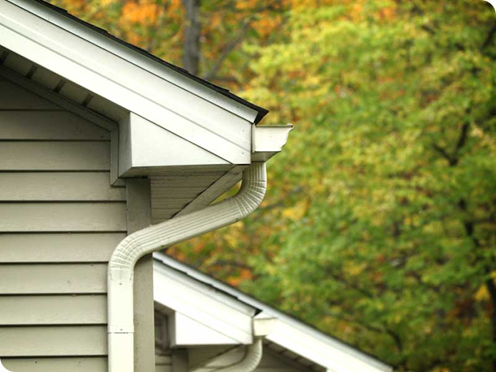A gutter apron is crucial to protecting your home from water damage and ensuring the longevity of your roof and gutters. This flashing component, often overlooked, prevents water from seeping behind the gutter, which protects the fascia and roof deck. In this guide, we’ll explore everything you need to know about gutter aprons, from understanding their purpose to tips on how to inspect your gutters like a pro and maintain them effectively. Whether you’re installing a new gutter system or maintaining an existing one, understanding gutter aprons can help prevent costly repairs and keep your home safe.
Need expert help with your roof? Contact Sky Roofer today for a free quote and professional advice on choosing the right roof trusses!
- 1. What is a Gutter Apron?
- 2. Why Do You Need a Gutter Apron?
- 3. Gutter Apron vs. Drip Edge: What’s the Difference?
- 4. What is Gutter Apron Flashing?
- 5. How to Install a Gutter Apron
- 6. How to Inspect Your Gutters like a Pro
- 7. Steps in the Gutter Inspection Process
- 8. Gutter Apron Maintenance Tips
- 9. Professional Gutter Inspections: When to Call an Expert
- 10. Conclusion
- FAQs
1. What is a Gutter Apron?
A gutter apron is a piece of metal flashing installed at the roof’s edge that helps direct rainwater into the gutters while preventing water from running behind them. This added protection keeps the fascia and roof deck safe from moisture damage, especially during heavy rain. Made from materials like aluminum, galvanized steel, or copper, gutter aprons play a key role in a home’s overall gutter system.

2. Why Do You Need a Gutter Apron?
Installing a gutter apron is essential for homes in regions prone to rain and storms. Without a gutter apron, water can seep behind the gutter, causing potential damage to the fascia, roof shingles, and even the home’s foundation. Over time, these issues can lead to costly repairs and structural damage. A gutter apron is an inexpensive addition that significantly boosts gutter performance and extends the lifespan of your roof.
3. Gutter Apron vs. Drip Edge: What’s the Difference?
While both gutter aprons and drip edges are types of flashing, they serve distinct purposes:
- Drip Edge: Sits along the roof edge to direct water away from the fascia.
- Gutter Apron: Extends further down into the gutter itself, offering extra protection by ensuring that water flows directly into the gutter, especially in homes with heavy rainfall.
A gutter apron provides a higher level of protection by preventing water from seeping behind the gutter, while the drip edge is mainly used to protect the fascia.

4. What is Gutter Apron Flashing?
Gutter apron flashing is installed beneath the roof shingles and extends over the gutter edge. This type of flashing is key to a seamless water flow into the gutters, helping to prevent leaks, mold, and rot. Installing high-quality gutter apron flashing can ensure that water flows directly into the gutters without leaking behind them, providing essential protection for your home’s structural components.
Benefits of Gutter Apron Flashing
- Protects Fascia and Roof Deck: Keeps water from seeping behind the gutter.
- Enhances Gutter Performance: Directs water directly into the gutter, reducing overflow.
- Reduces Maintenance Needs: Prevents mold and rot, lowering long-term maintenance costs.

5. How to Install a Gutter Apron
Proper installation of a gutter apron is critical to its effectiveness. Here’s a step-by-step guide for installing it yourself or for understanding the process of hiring a professional:
Step-by-Step Installation Guide
- Prepare the Right Tools: You’ll need a ladder, gutter apron flashing, drill, screws, tin snips, caulking gun, and safety gear.
- Measure and Cut Flashing: Measure your roofline, then cut the flashing to fit with a slight overlap of 2-3 inches.
- Lift Shingles Carefully: Use a pry bar to lift the shingles gently so you can slide the flashing underneath.
- Position and Secure: Place the flashing so that it aligns with the gutter and secures it with screws.
- Seal Overlaps: Apply waterproof sealant at overlap sections to prevent leaks.
- Test Water Flow: Run water along the roof edge to confirm it flows properly into the gutter.

6. How to Inspect Your Gutters like a Pro
Regular gutter inspections help prevent clogs and damage to the gutter apron and the gutter system. Here are tips to inspect your gutters like a pro:
- Clear Debris: Remove leaves, twigs, and dirt from the gutter.
- Inspect for Damage: Look for rust, cracks, or loose sections along the gutter apron and gutter itself.
- Test with Water: Run water through the gutter to check for leaks or blockages.
- Check during Rain: Observing your gutter apron in action during rain provides insights into any potential issues.
7. Steps in the Gutter Inspection Process
To ensure your gutters and gutter apron are performing optimally, follow this inspection process:
- Set up a Safe Ladder: Stabilize your ladder on flat ground and wear gloves.
- Clear Gutters of Debris: Use your hands or a gutter scoop to remove buildup.
- Inspect for Rust and Corrosion: Check the gutter apron and gutter for signs of rust, especially after heavy rains.
- Inspect Downspouts: Ensure downspouts are directing water away from your home’s foundation.
- Test Water Flow: Use a garden hose to ensure water flows easily to the downspout without leaks.
8. Gutter Apron Maintenance Tips
Regular maintenance helps extend the life of your gutter apron and gutter system. Here are key tips:
- Routine Cleaning: Clear gutters and apron areas of leaves and dirt.
- Rust Prevention: Check metal gutter aprons for rust spots, which can spread if left untreated.
- Secure Fastening: Ensure the gutter apron stays tightly fastened to the roof to avoid detachment.
- Inspect After Severe Weather: High winds and heavy rain can loosen gutter aprons, so check them afterward.

9. Professional Gutter Inspections: When to Call an Expert
While basic inspections are manageable for most homeowners, some issues require a professional touch. Call an expert if you notice:
- Persistent leaks behind the gutter.
- Extensive rust or damage to the gutter apron.
- A loose or detached gutter apron.
Hiring a professional can help uncover hidden issues that, if left unresolved, could result in costly repairs down the line.
10. Conclusion
A gutter apron may seem like a minor part of your gutter system, but it’s critical for protecting your home from water damage. With proper installation, routine inspections, and maintenance, a gutter apron can help ensure your gutter system runs efficiently, safeguarding your home’s structure and foundation. By following this guide, you can better understand the importance of gutter aprons and feel confident in making informed decisions to protect your home.
FAQs
1. What is the primary function of a gutter apron?
A gutter apron protects the fascia and roof deck by directing water directly into the gutters and preventing water from running behind them.
2. Is a gutter apron necessary for all homes?
While not mandatory, a gutter apron is highly recommended, especially in areas with heavy rainfall, as it provides essential protection against water damage.
3. How often should I inspect my gutter apron?
At least twice a year, especially after severe weather. Regular inspections prevent issues from developing into costly repairs.
4. Can I install a gutter apron myself?
Yes, with the right tools and guidance. However, if you’re uncomfortable with heights or unsure about the process, hiring a professional may be best.
5. What materials are best for gutter aprons?
Aluminum, galvanized steel, and copper are popular for their durability and water resistance.
Looking for gutter apron for your metal roof? Learn more about our services and contact Sky Roofer for expert guidance.




Pingback: What is the Difference Between Trim and Fascia? | Sky Roofer
Pingback: Gutter Apron vs. Drip Edge: What’s the Difference? | Sky Roofer